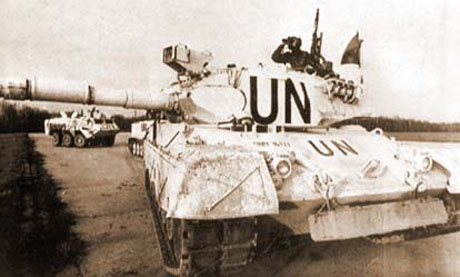In April, 1994, Danish crews in German Leopard tanks responded to a Swedish outpost's request for help as part of the UN's peacekeeping mission in Bosnia. The Swedish outpost, Tango 2, near the village of Kalesija was under heavy artillery fire from the Bosnian Serb Šekovici Brigade. The Danish contingent responded to the request for help, and seven Leopard tanks and one APC (armored personnel carrier) started for the scene.
The Leopard's had just been upgraded to the use of thermal systems to guide their fire at night, and also included a computer controlled laser guided fire control system to assist in range finding. Also a gun stabilization system was installed, all which came in handy in the hours to come. The area the tanks were stationed in, around the airfield at Tuzla, had been shelled repeatedly, and an operative plan was in place to counter the Serb activity, and this plan was called Operation Bollebank (or "Hooligan Bashing" in English).
Image from Danish Military History

En route to the observation post, the tanks came immediately under fire from concealed Serbs. The tanks didn't slow down till 15 minutes later when they had to make a sharp turn. Then the tanks came under fire from anti-tank missiles. That was enough, and the Danish tanks returned fire. They could see the muzzle flashes of their tormentors, and asked for an air strike, which was denied. The tanks weathered the artillery storm well, but the commander realized that the only way it could end well for the Danes was to let the Serbs have it. Two tanks who had already made the sharp turn continued on to the observation post, where the shooting stopped on their arrival, and where they stayed for a couple of days after that. After most of the antagonists were silenced at the ambush site, it was decided that those last five tanks and the APC would return to base. The firing began anew and they had to fight their way out, causing a tremendous explosion in the Serb's midst. Amongst other weapons, the Danes fired 72 105 rounds against the Serbs, and not losing any of their soldiers. The Serbs casualties are listed anywhere from 9 to 150 men, depending on the source.
This was probably the biggest Danish military operation since the 1860's, in which they fought a disastrous war against the Prussians and Austrians. It was also the first time the Leopard's guns had been fired in anger. Operation Bollebank was probably one of Denmark's and the UN's finer hours.